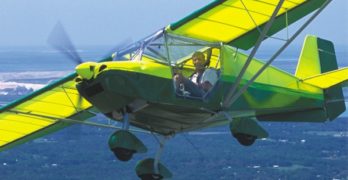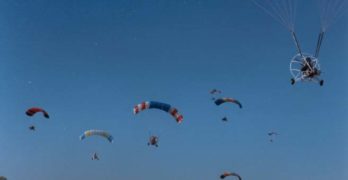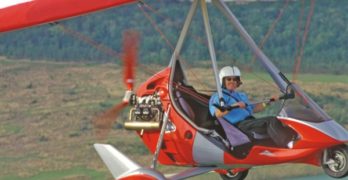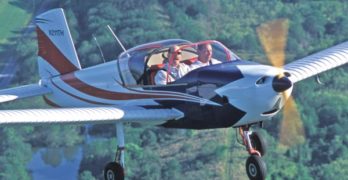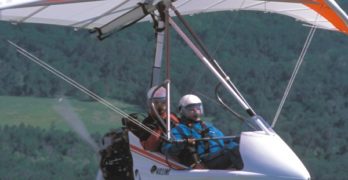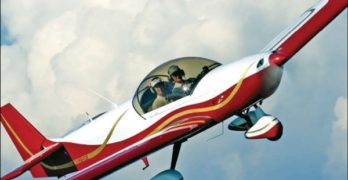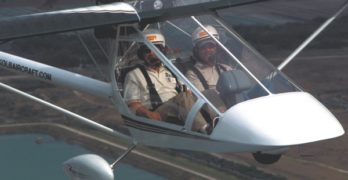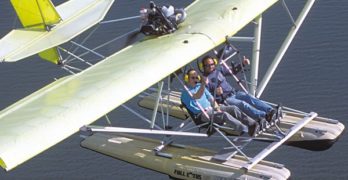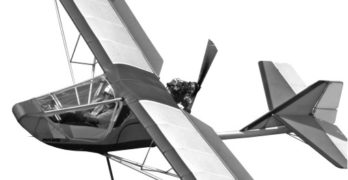Listening to the aviation media drumbeat about Sport Pilot/Light-Sport Aircraft, you could be excused for thinking ultralights had “vanished” and that it now takes $55,000 to $95,000 to buy a light recreational aircraft. Fortunately, this just isn’t so.
We’re beginning to identify the emergence of a middle ground and the Sky Ranger is positioned in this space. According to my Sky Ranger check pilot Ryan Gross, our test plane could be supplied by Sky Ranger Aircraft Company for $40,000 in ready-to-fly form. While this is significantly more than the Sky Ranger 503 kit I flew four years ago, it is about half the cost of the average new 3-axis light-sport aircraft (LSA), though some models, like the Fantasy Air Allegro 2000, are only $15,000 more than the Sky Ranger.
Regardless of how the Sky Ranger Aircraft Company may elect to supply fully-built aircraft versus kits, the design of this airplane was optimized to be a quick and easily-built kit.
Search Results for : CT AND hand control
Not finding exactly what you expected? Try our advanced search option.
Select a manufacturer to go straight to all our content about that manufacturer.
Select an aircraft model to go straight to all our content about that model.
Powrachutes on the Prairie
Only three weeks earlier, our nation had endured wrenching emotion from the September 11 attacks. But life must go on.
So Powrachute of Columbus, Kansas, went on with its third annual Extravaganza. One look at the grounds promised that this was to be no ordinary company fly-in. Most of them resemble a family picnic; this one looked like an airshow.
For the 2001 Extravaganza, Powrachute reported an attendance of 5000 spectators. Greeting them in this year of uncertainty was a beautifully airbrushed bald eagle against an American flag backdrop. The art took up 15,600 square feet of the flying field.
Mass Launch
Extravaganza participants came from 29 states plus Canada, and they brought 215 aircraft. Much like the giant hot-air balloon fiesta in Albuquerque, New Mexico, the Powrachute gathering provided a great photo opportunity to capture the large and colorful wings of aviation’s newest segment.
On one occasion during the four-day event, a launch of powered parachutes put 80 of them in the air in 20 minutes.
The Tanarg: Most Deluxe Trike Ever?
When Air Création introduced their beautiful Tanarg trike to American pilots in 2005, it earned a very warm response and, at the same time, shock at its $53,000 price tag – some $10,000 more than the next closest high-end trike.
Pronounced Tan-ARG (rhyme it with “barge,” except the G is said softly, more like TAN-arz), the machine is impressive. Even for those pilots or newcomers who regard weight-shift control trikes as “weird,” or “hard to understand,” the Tanarg design concept earns respect rapidly. This aircraft has received enormous attention to detail while also gaining in strength and ease of use. Air Création engineers built on many successful years of designing and producing lots of trikes – some 2,500 of them – to create a stunning work of aeronautical art. Nothing on the market is quite like the Tanarg.
The last time I wrote about Air Création, I talked about my experience with their wonderful new iXess wing (once again introducing a hard-to-pronounce name).
IndUS Sky Skooter…Proven Trainer with ePod
he proven airframe and modern panel of the Sky Skooter make perhaps the oddest, yet most appropriate of mates. Each from a different age – the T-211’s unique ribbed wing beckons from the 1940s while the ePod streaks ahead in the 2000s – they nonetheless complement each other.
The Sky Skooter is the fun little variant of the T-211 series, including the FAA-certified T-211 and the ASTM standards-compliant (LSA certified) Thorpedo. The company can deliver just about any version of John Thorp’s groundbreaking design, the very one that lead to Piper’s Cherokee, which sold tens of thousands.
Complementing the joyful and innocent Sky Skooter with the most pleasant in-flight handling comes the visitor from the future: IndUS Aviation’s ePod. Putting these together for a flight review shows the past and the future of light-sport aviation.
Long Perspective
The T-211 has a long, rich aviation history. The model dates back to designs studies in the early 1940s that lead to the Lockheed Little Dipper, a single-place light aircraft created by legendary designer John Thorp.
GT Ultralights: A Versatile Trike Supplier
Ukrainian airframe producer Aeros has risen from complete obscurity in the early 1990s (after the Berlin Wall fell) to wide recognition in recreational aviation. Although powered ultralight and light-sport aircraft enthusiasts may not immediately know the brand, hang glider pilots around the world are very aware of the name. The current reigning world champion hang glider pilot is Oleg Bondarchuck, a Ukrainian pilot who works with Aeros.
This young company emerging from the former Soviet mantel also makes an ultralight sailplane plus two powered aircraft. Aeros produces the Sky Ranger 3-axis airplane (under agreement with its French designer), and it has designed and markets its own trike. The company also supplies trike wings for other producers like Antares. By any normal measurements, Aeros is a versatile company.
Many ultralight and LSA pilots probably know the Aeros Velocity trike, and may recall its earlier name, Venture. In those days, it was sold by Sabre Aircraft alongside the trikes that Arizona company made here in America.
Have it your way…CH-601 XL or XLi
The strongest interest in readyto-
fly special light-sport aircraft
(S-LSA) to date has come
from pilots operating Cessna, Piper,
Mooney, and other general aviation
(GA) aircraft. It is estimated that more
than 100,000 currently certificated pilots
are looking at their prospects for
maintaining an up-to-date second- or
third-class FAA medical and considering
the LSA option. Many are concluding
that LSA are worthy airplanes
and recognize that downsizing to an
LSA two-seater can meet their flying
goals, a fact that has driven a good
share of LSA sales thus far.
Thousands of those pilots have private
or higher certificates with instrument
ratings. They’re accustomed to
having a full panel and want one even
if flying in instrument meteorological
conditions (IMC) isn’t in their plans. In
fact, flashy dual-screen plus electronic
information and navigation panel
layouts have proven quite popular in
many S-LSA, even though they add tens
of thousands of dollars in cost.
Refined Kolb Mark III Xtra
“Xtra” - a word to make a computer spell-checker stumble – is an appropriate name for this month’s pilot’s report, The New Kolb Aircraft Company Mark III Xtra side-by-side 2-seater. It literally offers extra in several ways pilots will like.
The venerable Mark III has been through a series of changes since original company founder Homer Kolb first brought out a 2-seater called the TwinStar. The latest change does a lot to alter the appearance of the older design.
Kolb designs have narrow noses like a lot of other designs. The new Xtra presents a clean edge cutting through the air, but it now has a wider look – at least from head-on – that imparts a new feel to the occupants. Some will say the “Xtra” comes from “Extra-Wide.” With its bulging doors, the new cabin is 45 inches wide (42.5 at the hips).
Although the design will look bigger and heavier to some, the new shape is one you’ll come to like… if you have a seat.
Co-Developing the Navajo Trike
A couple of years ago, TC’s Trikes owner TC Blyth and North Wing owner Kamron Blevins joined forces in a cooperative arrangement. TC’s Trikes would buy wings from North Wing (rather than continue to make their own), and could better represent North Wing on the Eastern Seaboard. North Wing, headquartered in the northwestern state of Washington, is far from TC’s Trikes’ Tennessee home. It seemed a marriage of convenience and more.
Blyth has been particularly active in training and introductory flight lessons. He’s done many thousands of them at his location near a top Tennessee tourist and outdoorsmen attraction – the Ocoee River, popular for white water rafting, kayaking, and other sports. Blyth has been focused on meeting this need with his own brand of trikes, and all his experience gave him something clear and viable to add to the expertise of North Wing.
North Wing has risen to the top of the U.S.
Float-Flying the M-Squared Sprint 1000
“Air in your hair!
Space on your face! A breeze on your knees!” A former colleague of mine used to repeat this short mantra to illustrate the joy of open-cockpit flying. It was catchy and engaging and his customers liked it.
With 15 Light-Sport Aircraft now possessing their FAA Special Light-Sport Aircraft (SLSA) airworthiness certificates, not a single one is open cockpit, though the IndUS Thorpedo, Legend Cub, and Tecnam Sierra can enjoy partially open cockpits.
Special Light-Sport Aircraft will eventually add more of this genre of light aircraft but one of the beauties of FAA’s new regulation is that it does not eliminate two previous categories: Amateur-built 51% kits or Part 103-compliant ultralights.
With 21¼4 years left before operators of 2-seat 496-pound empty weight ultralight exempt trainers must register in FAA’s new Light-Sport Aircraft category, and with 41¼4 years left while these machines can be used for compensated training flights, the segment still has lots of life remaining.
CGS Aviation Makes Hawk
Remember why we fly ultralights? Few general aviation airplanes are flown below 1,500 feet above the ground. More rare is flight at 500 feet or 50 feet. Neither do you tend to fly most light-sport aircraft (LSAs) at these denser altitudes. Most flights in general aviation or LSA planes start out climbing high as quickly as possible. You switch on the autopilot as soon as possible and fiddle with the throttle, prop and mixture controls to squeeze all the fuel economy you can while flying as fast as the machine will manage in the straightest possible line all the way to your destination.
That’s fine for general aviation or LSA flying, and it’s enjoyable in a different way. But it isn’t ultralight flying.
What about just “boating around” the sky at your leisure, turning every few minutes to see the sights only possible from an ultralight aircraft. Your eye catches an alligator off to one side and you bank quickly to check it out.
- « Previous Page
- 1
- …
- 43
- 44
- 45
- 46
- 47
- …
- 61
- Next Page »


